Supernova in the Pinwheel Galaxy. Supernova 2023ixf, in M101 off the Big Dipper, is fading gradually; as of July 7th it was magnitude 12.1, down from its May 25th peak of 11.1. It's also slightly "reddening" — actually, yellowing. See Bright Supernova Blazes in M101 for charts and comparison magnitudes.
FRIDAY, JULY 7
■ Upper left of Venus in twilight, Mars is now less than 2° from Regulus; see the scene below. Once you spot Venus after sunset (or even before sunset), how much longer will it be until you definitely detect the star, then the planet? Regulus is magnitude 1.4, Mars is 1.7, meaning Mars is one-third fainter.1
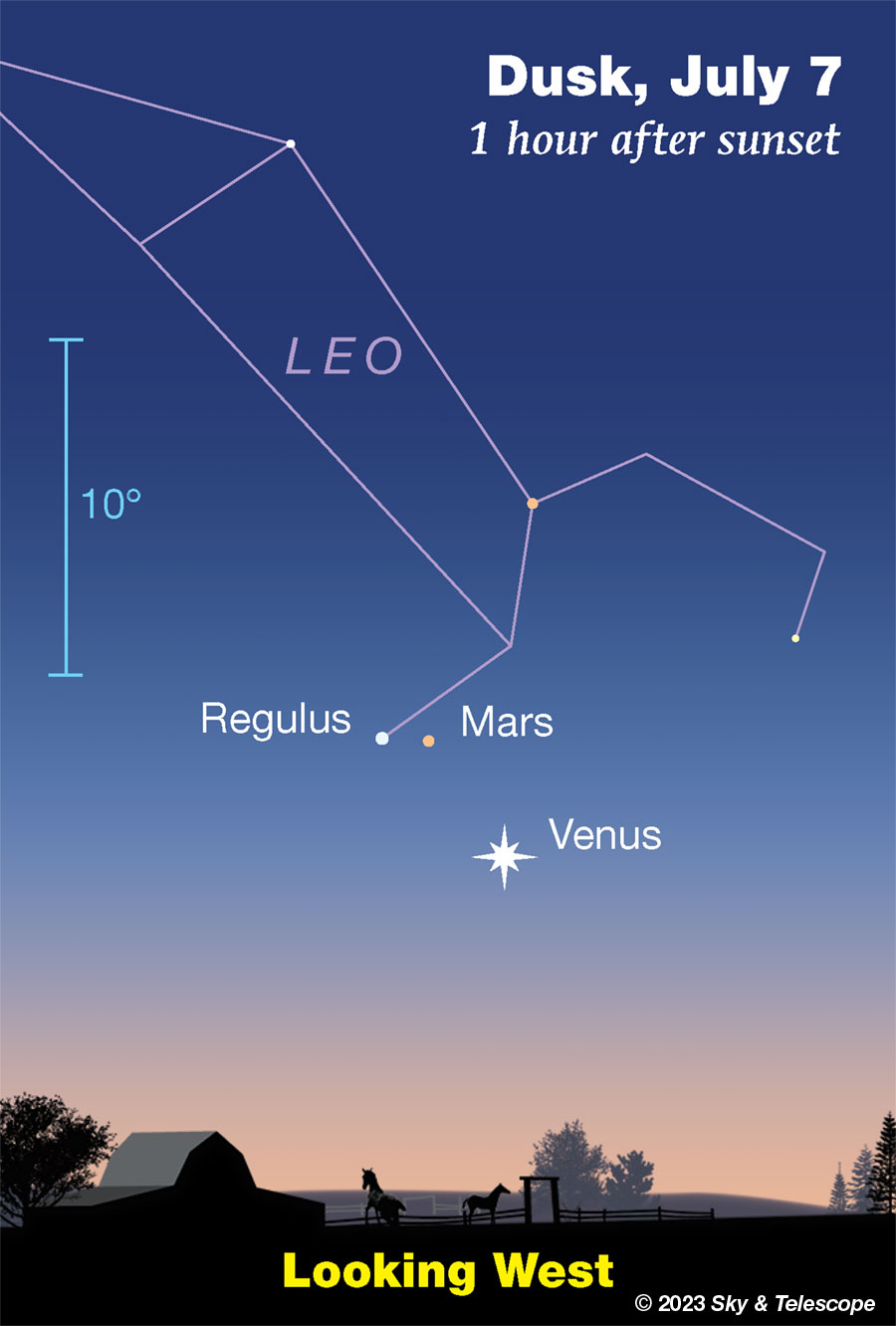
SATURDAY, JULY 8
■ Three doubles at the top of Scorpius. The head of Scorpius — the near-vertical row of three stars upper right of Antares — stands due south right after dark. The top star of the row is Beta Scorpii or Graffias, a fine double star for telescopes: separation 13 arcseconds, magnitudes 2.8 and 5.0.
Just 1° below it is the very wide naked-eye pair Omega1 and Omega2 Scorpii, aligned diagonally. They're 4th magnitude and a wide ¼° apart. Binoculars show their slight color difference; they're spectral types B9 and G2.
Upper left of Beta by 1.6° is Nu Scorpii, separation 41 arcseconds, magnitudes 3.8 and 6.5. In fact this is a telescopic triple. High power in excellent seeing reveals Nu's brighter component itself to be a close binary, separation 2 arcseconds, magnitudes 4.0 and 5.3, aligned almost north-south.
SUNDAY, JULY 9
■ Mars and Regulus, upper left of Venus in late twilight, are in conjunction this evening and tomorrow evening, 0.7° apart.
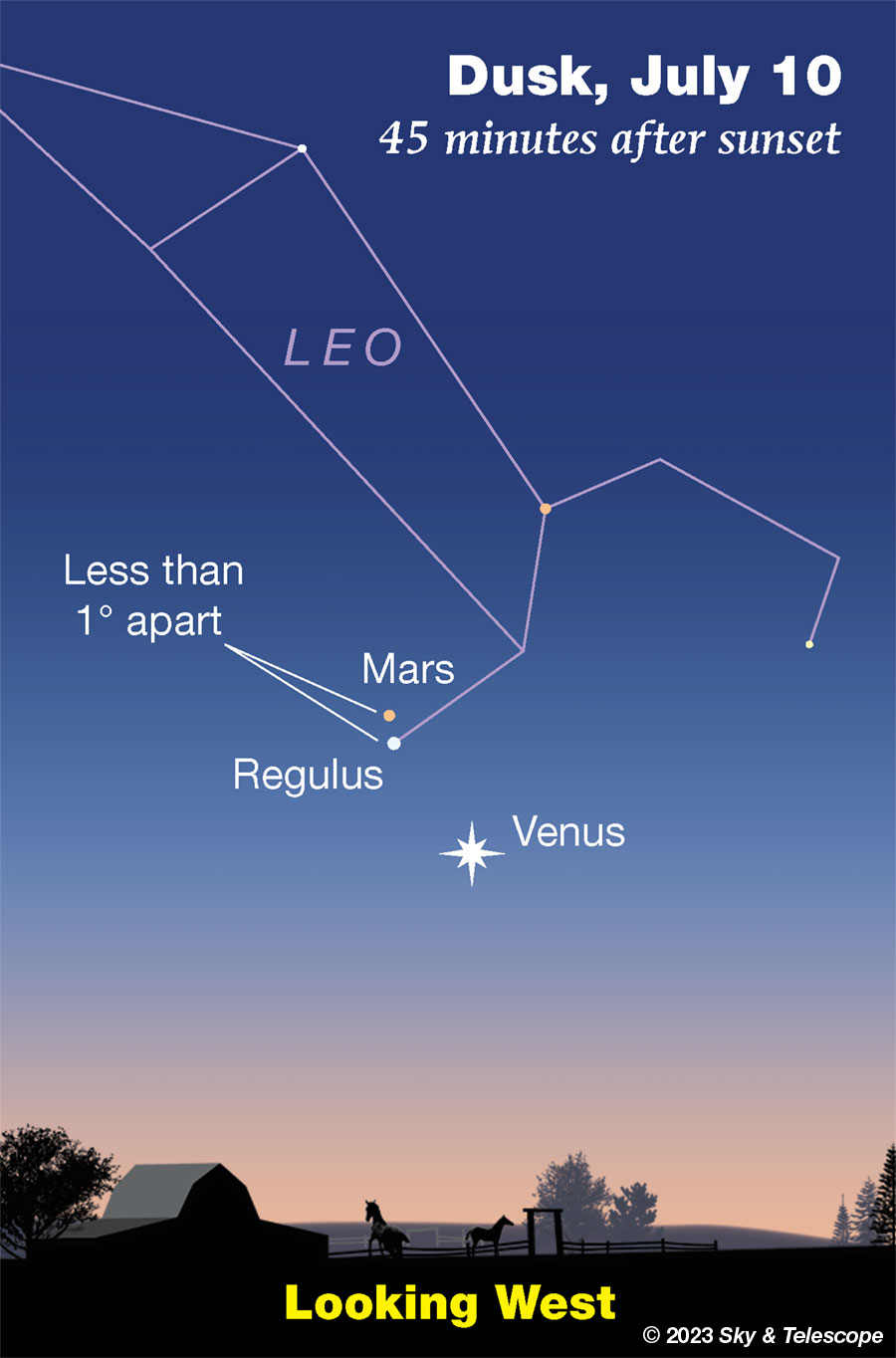
■ Last-quarter Moon (exact at 9:48 p.m. EDT). The Moon rises around 1 a.m. in Pisces. By the beginning of dawn it's high in the south, with bright Jupiter about two fists to its left and Saturn more than twice as far to its right.
MONDAY, JULY 10
■ The Moon, just past last quarter, rises around 1 a.m. tonight and Jupiter follows it up about 20 minutes later. By early dawn Tuesday morning they're high in the east-southeast, with Jupiter to the Moon's lower left.
TUESDAY, JULY 11
■ In early dawn on Wednesday, Jupiter shines upper right of the Moon. If it's still dark enough, look for the Pleiades to the Moon's lower left, as shown below.
On Thursday morning, the Pleiades are closer above the Moon.
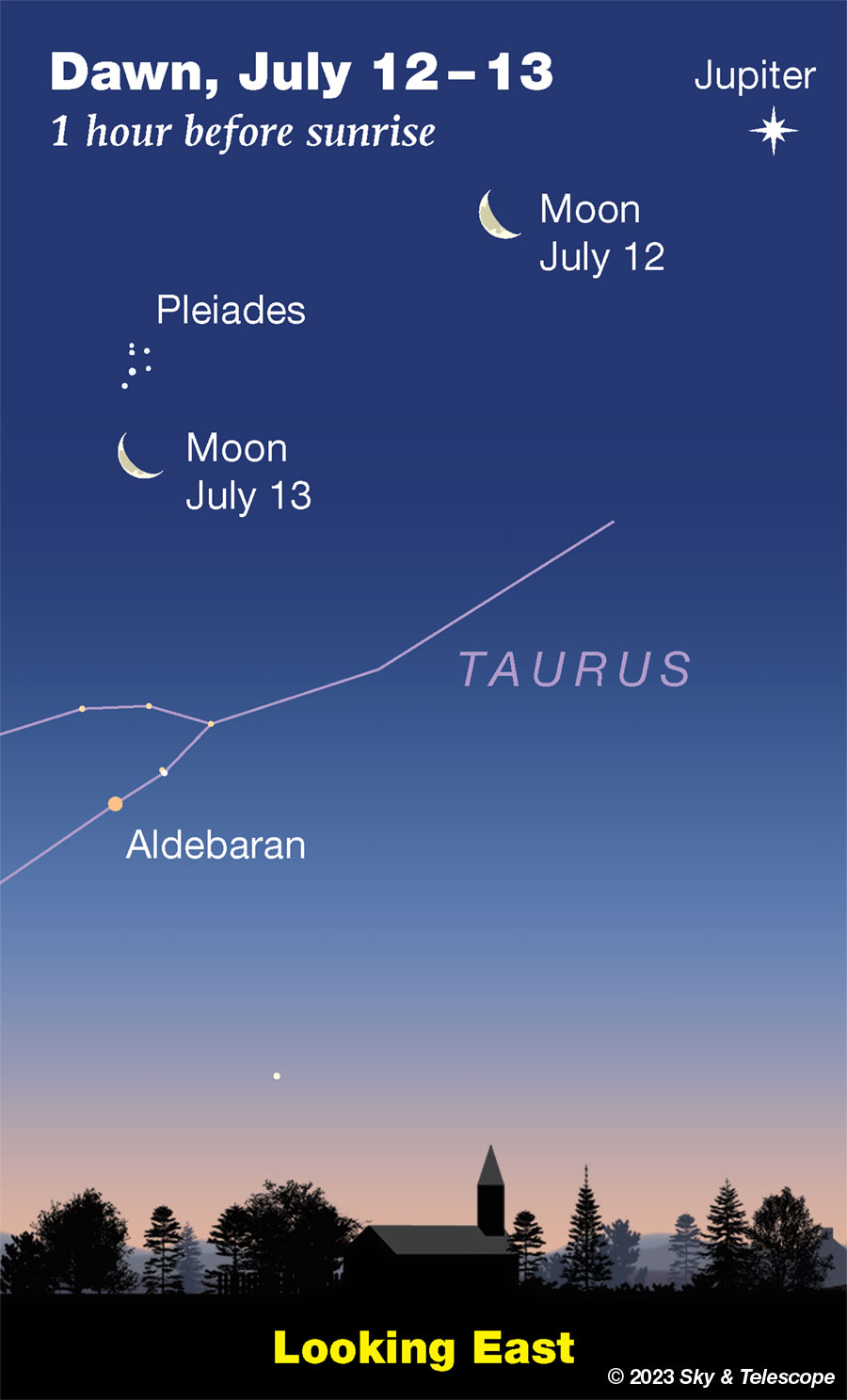
■ One hour after sunset, as twilight is fading and the stars are coming out, you'll find the two brightest stars of summer, Vega and Arcturus, equally near the zenith: Vega toward the east, Arcturus toward the southwest (depending on your location).
Different people have an easier or harder time seeing star colors, especially subtle ones. Vega is white with just a touch of icy blue. Arcturus is a yellow-orange giant. To me, their tints show a little better against the deep blue of late twilight rather than against the black of night.
WEDNESDAY JULY 12
■ Low in the northwest or north at the end of these long summer twilights, would you recognize noctilucent clouds if you saw them? They're the most astronomical of all cloud types, with their extreme altitude and formation on, among other things, meteoric dust particles. I think they're also the most beautiful.
Noctilucent cloud season runs from mid-May to mid-August (in the Northern Hemisphere). They used to be rare but they're becoming more common, probably due to the extra methane being released into the atmosphere by climate change. See Bob King's article.
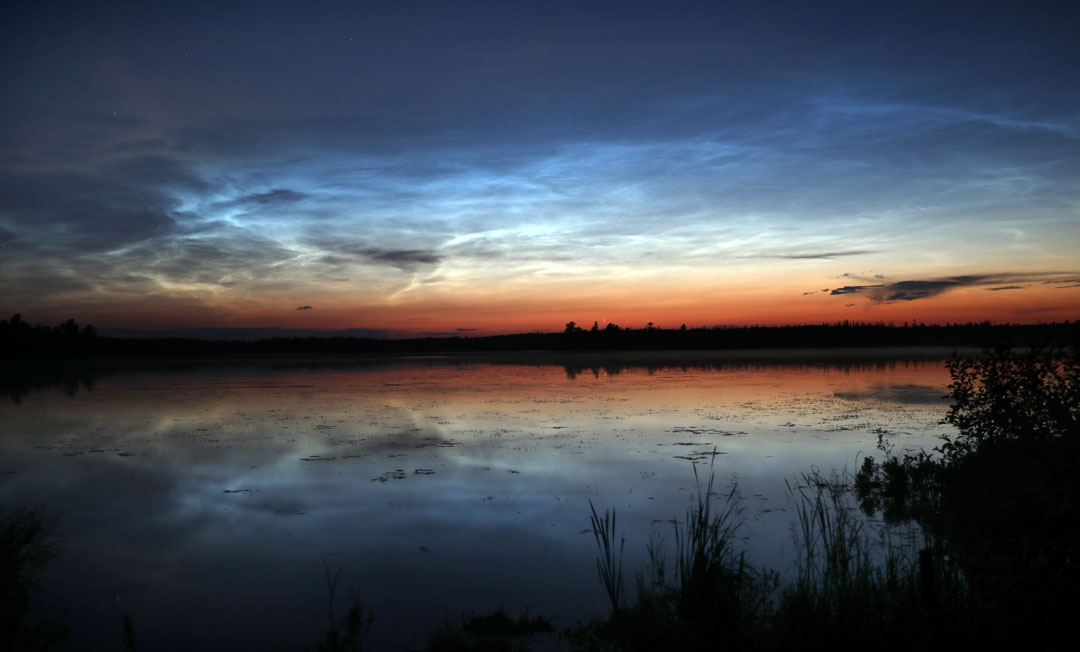
THURSDAY, JULY 13
■ Starry Scorpius is sometimes called "the Orion of Summer" — for its brightness, its blue-white giant stars, and its prominent red supergiant (Antares in the case of Scorpius, Betelgeuse for Orion). But Scorpius passes a lot lower across the southern sky than Orion does, for those of us at mid-northern latitudes. That means it has only one really good evening month: July.
Catch Scorpius at its highest in early to mid evening now, before it starts to tilt lower toward the southwest. It's full of deep-sky objects to hunt with binoculars or a telescope and a sky atlas.
FRIDAY, JULY 14
■ After dark Altair shines in the east-southeast. It's the second-brightest star on the eastern side of the sky, after Vega high to its upper left. The third star of the Summer Triangle is Deneb, less bright, to their left.
Above Altair by a finger-width at arm's length is little Tarazed, 3rd magnitude and orange, which helps to identify it.
Altair is a fast-spinning, white type-A star, somewhat larger and hotter than the Sun, only 17 light-years away. It spins so fast that, using interferometry, astronomers were able in 1999 to confirm that it is widened around its equator into a very ellipsoid shape. A later direct image is below.
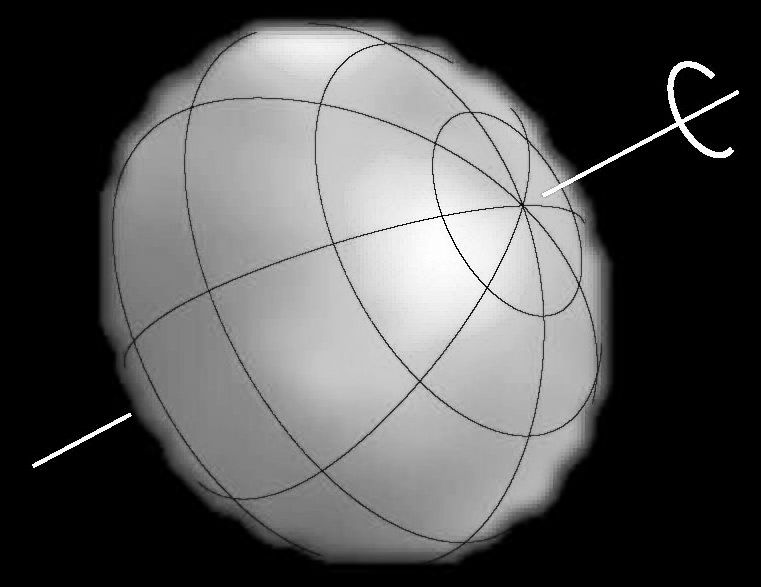
SATURDAY, JULY 15
■ Now that Altair is getting nice and high in the east-southeast and the evenings are moonless, it's time to greet the Dolphin and the Arrow.
Look for little Delphinus about a fist at arm's length lower left of Altair. He's leaping leftward just below the summer Milky Way.
Sagitta, the Arrow, is smaller and fainter. Look for it closer to Altair's upper left. The Arrow points lower left past the Dolphin's nose. For more on Sagitta and its telescopic cluster M71, see the July Sky & Telescope, page 43.
Also in the vicinity is the lovely little binocular asterism The Coathanger. It's 4° above (northwest of) Sagitta's tail and currently poses upside down. See page 54 of the July Sky & Telescope, which includes lots of telescopic sights around it.
SUNDAY, JULY 16
■ The tail of Scorpius is low due south after dark, to the lower right of the Sagittarius Teapot. How low depends on how far north or south you live: the farther south, the higher.
Look for the two stars especially close together in the tail. These are Lambda and fainter Upsilon Scorpii, known as the Cat's Eyes. They're 0.6° apart and canted at an angle; the cat is tilting its head to the right. And the cat has a bleary eye; Upsilon is fainter than Lambda (they're magnitudes 2.6 and 1.6). Both are blue-white giants, 500 and 700 light years away, respectively. Yes, the fainter one is the nearer one.
Between the Cat's Eyes and the Teapot's spout are the open star clusters M6 and especially M7, showy in binoculars.
A line through the Cat's Eyes points west (right) by nearly a fist-width toward Mu Scorpii, a much tighter pair known as the Little Cat's Eyes. They're oriented almost exactly the same way as Lambda and Upsilon. If you have very sharp eyes, can you resolve the Mu pair without using binoculars?
This Week's Planet Roundup
Mercury is very deep in the glow of sunset, but a little less so each day. Starting around July 12th, you might start looking for it just above the west-northwest horizon about 20 minutes after sunset. It's 23° lower right of Venus on that date. Binoculars help. At least Mercury is bright now, magnitude –0.9 on that date.
Venus moves toward it by about a degree a day.
Venus (magnitude –4.7) is the "Evening Star" dominating the low west in twilight. It's dropping sunward faster now day by day. It sets while twilight is still in progress.
Get your telescope on Venus as early as you can, preferably during late afternoon in a clear blue sky while it's still high. Venus is a tiny white crescent, enlarging and thinning and as it swings closer to Earth and closer to our line of sight to the Sun. From July 7th to 14th it expands from about 37 to 42 arcseconds in diameter while waning from 26% to 19% sunlit. It will continue to swell in diameter and thin in phase as it drops lower. It will be lost from sight later in the month.
Even good binoculars, steadily braced, are enough, or soon will be, to show Venus's tiny crescent. But with the naked eye? Mere 20/20 vision isn't good enough; success may await the eagle-eyed with 20/15, 20/12, 0r (rare) 20/10 vision. Try during different stages of twilight before the sky becomes too dark and Venus's glare too spready.
You may improve your chances by sighting through a clean, round hole in a stiff piece of paper 1 mm, 2mm, or 3mm in diameter (try them all). This will mask out the optical aberrations that are common away from the center of your eye's cornea and lens.
One who apparently succeeded in spotting the crescent of Venus was Edgar Allan Poe, as memorialized in his haunting poem "Ulalume." See my story about that in December 2021; scroll down here to the Planet Roundup.
Mars (magnitude 1.7) glows weakly to Venus's upper left low in the west at dusk. They're beginning to draw apart; 4° separates Mars and Venus on July 7th, 6° on the 14th.
Mars this week closely passes Regulus. Star and planet are closest on July 9th and 10th, 0.7° apart. Regulus is magnitude 1.4 and Mars is 1.7, so you'll probably see Regulus first as twilight fades.
In a telescope Mars is just a tiny blob 4.2 arcseconds in diameter, since it's on the far side of its orbit from us. And it's a small planet to begin with.
Jupiter (magnitude –2.3, in Aries) rises around 1 or 2 a.m. in the east-northeast. By the beginning of dawn it's shining high in the east.
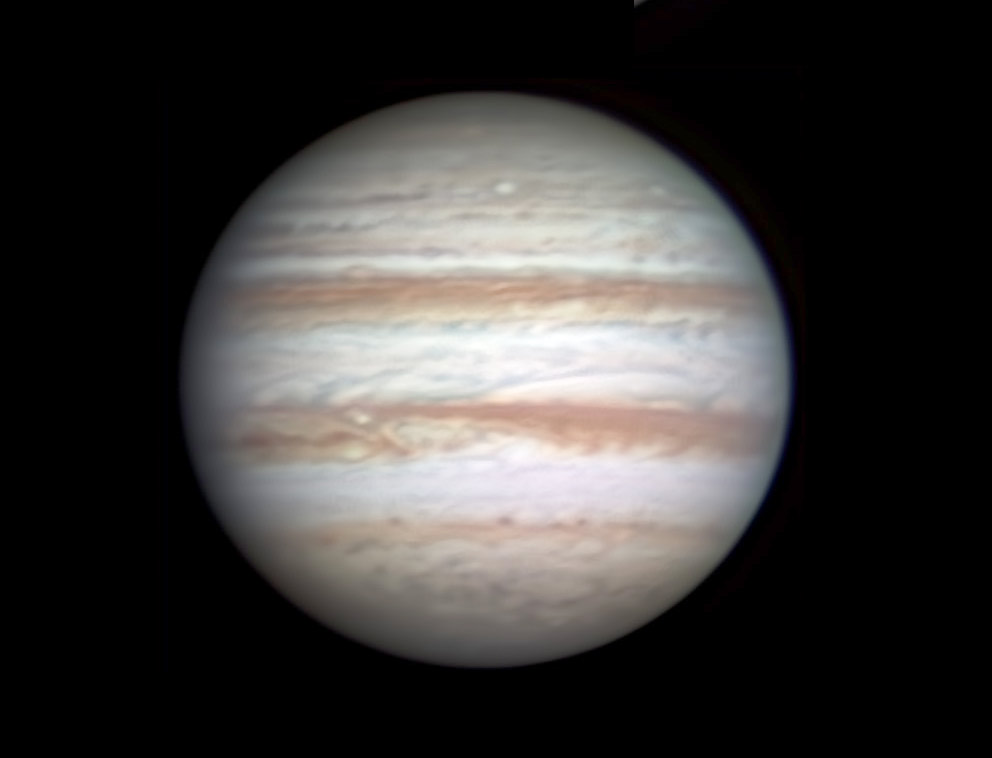
Saturn (magnitude +0.8, in dim Aquarius) rises around 11 p.m. It's at its highest in the south and sharpest and steadiest in a telescope just before dawn begins. The 1st-magnitude star about two fists below it then is Fomalhaut.
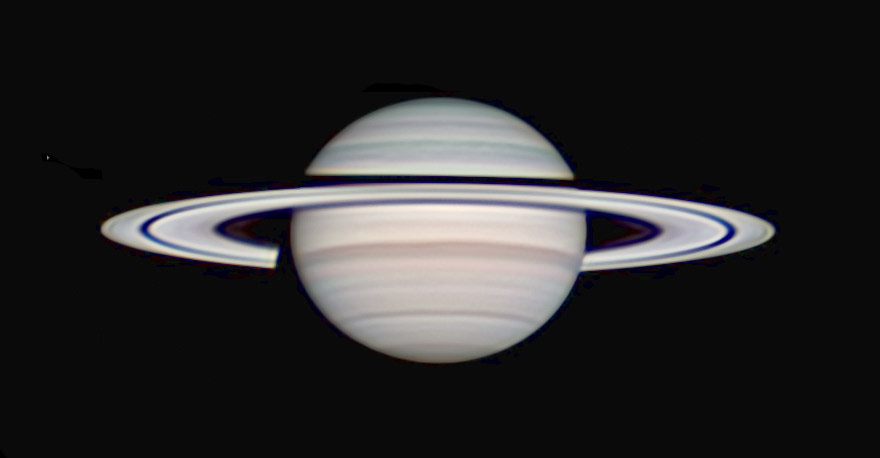
Uranus, magnitude 5.8 in Aries, is in the east-northeast by the beginning of dawn (about 11° lower left of Jupiter).
Neptune, magnitude 7.9 at the Aquarius-Pisces border, is high in the southeast before dawn begins, 20° east along the ecliptic from Saturn.
All descriptions that relate to your horizon — including the words up, down, right, and left — are written for the world's mid-northern latitudes. Descriptions and graphics that also depend on longitude (mainly Moon positions) are for North America.
Eastern Daylight Time (EDT) is Universal Time minus 4 hours. UT is sometimes called UTC, GMT, or Z time.
Want to become a better astronomer? Learn your way around the constellations. They're the key to locating everything fainter and deeper to hunt with binoculars or a telescope.
This is an outdoor nature hobby. For a more detailed constellation guide covering the whole evening sky, use the big monthly map in the center of each issue of Sky & Telescope, the essential magazine of astronomy.
Once you get a telescope, to put it to good use you'll need a much more detailed, large-scale sky atlas (set of charts). The basic standard is the Pocket Sky Atlas (in either the original or Jumbo Edition), which shows all stars to magnitude 7.6.

Next up is the larger and deeper Sky Atlas 2000.0, plotting stars to magnitude 8.5; nearly three times as many. The next up, once you know your way around, are the even larger Interstellarum atlas (stars to magnitude 9.5) or Uranometria 2000.0 (stars to mag 9.75). And be sure to read How to Use a Star Chart with a Telescope. It applies just as much to charts on your phone or tablet as to charts on paper.
You'll also want a good deep-sky guidebook. A beloved old classic is the three-volume Burnham's Celestial Handbook. An impressive more modern one is the big Night Sky Observer's Guide set (2+ volumes) by Kepple and Sanner.
Do computerized telescopes replace charts? Not for beginners I don't think, especially not on mounts and tripods that are less than top-quality mechanically. Unless you really prefer spending your time getting finicky technology to work rather than getting to know the sky. As Terence Dickinson and Alan Dyer say in their Backyard Astronomer's Guide, "A full appreciation of the universe cannot come without developing the skills to find things in the sky and understanding how the sky works. This knowledge comes only by spending time under the stars with star maps in hand."
But for finding faint objects that's not simple, either. How to Use a Star Chart with a Telescope tells the tricks.
![]() Audio sky tour. Out under the evening sky with your
Audio sky tour. Out under the evening sky with your
earbuds in place, listen to Kelly Beatty's monthly
podcast tour of the naked-eye heavens above. It's free.
"The dangers of not thinking clearly are much greater now than ever before. It's not that there's something new in our way of thinking, it's that credulous and confused thinking can be much more lethal in ways it was never before."
— Carl Sagan, 1996
"Facts are stubborn things."
— John Adams, 1770
1. Okay, some of you have asked how to convert a magnitude difference into the actual brightness ratio. Here we go.
The stellar magnitude system is defined so that 5 magnitudes is a brightness ratio of exactly 100 to 1. So, one magnitude is a brightness difference of the fifth root of 100. Which is 2.512 for all practical purposes.
So here's the formula to use: If Δm is the magnitude difference, then
brightness difference = 2.512Δm
...which is just a few taps on your scientific calculator.
 6
6









Comments
Anthony Barreiro
July 7, 2023 at 5:25 pm
Another huge sunspot is coming into view on the Sun's (celestial) southeastern limb. AR3363. Spaceweather.com has an interesting story. The sunspot was first observed by the Perseverance rover on Mars! Because Mars is currently on the other side of the Sun from Earth, the Martians can see most of the far side of the Sun. Perseverance checks the brightness of the Sun every day to measure the amount of dust in the atmosphere. Sometimes it sees sunspots, like this one.
https://spaceweather.com/archive.php?view=1&day=07&month=07&year=2023
You must be logged in to post a comment.
mary beth
July 9, 2023 at 11:21 pm
Hi Anthony! Good to see you here. Very interesting article and photos! Thank you!
You must be logged in to post a comment.
Rod
July 10, 2023 at 7:31 am
I hope for some stargazing tonight, but weather looks better early tomorrow morning near 0400 for Jupiter, waning crescent Moon, and Saturn. I plan to get out my 90-mm refractor telescope for some observations. More pool time (indoors and outdoors) now and grass cutting 🙂 Anthony sunspot note I read about and thought about viewing but clouds and local t-storms popped up. I also spent too much time at the pool too 🙂
You must be logged in to post a comment.
Rod
July 11, 2023 at 6:08 am
I did get out this morning and enjoy some early observations 🙂
Observed 0345-0515 EDT. Sunrise near 0551 EDT. Last Quarter Moon 10-July-2023 0148 UT so waning crescent this morning. I enjoyed views of Jupiter, Io shadow transit, views of various craters along terminator line of the Moon, Saturn, Titan, and Rhea moons visible at 71x. I used #58 green filter for Jupiter and the Io shadow transit as well as lunar observations. Io shadow transit began 0832/0835 UT, a tiny spot visible especially about 10 minutes later and near 0500 EDT. The #58 green filter enhances cloud bands on Jupiter and shadow transits of the Galilean moons as well as Great Red Spot transits. Saturn ring system is much more narrow view now compared to wider angle sights I enjoyed in the past. Some hint of cloud banding noticeable at Saturn. Copernicus crater on the Moon and many others in southern region along the terminator line quite distinct at 71x. I used my 90-mm refractor telescope with TeleVue 14-mm Delos eyepiece. Weather clear skies, temperature 18C with NW winds 4 knots. 3 satellites passed near Saturn position. One moving east, the others moving south. All were about 2nd or 3rd magnitude. Jupiter and the Moon in Aries, Saturn in Aquarius. The Moon and Jupiter about 6-degrees apart near 0400 EDT.
You must be logged in to post a comment.
mary beth
July 12, 2023 at 10:23 am
So glad to hear you had clear (enough) skies! Nice report!
You must be logged in to post a comment.
Rod
July 13, 2023 at 8:33 am
mary beth et al. Something I notice more and more when viewing the heavens with my binoculars, and telescopes from MD. I see more and more satellites moving by, sometimes bright in the eyepiece, my 10-inch shows this and 90-mm refractor as well as 10x50 binocular views. While I was looking at Saturn with the telescope, a fairly bright satellite passed near Saturn position, very visible in the eyepiece field of view. I am glad I do not take pictures.
You must be logged in to post a comment.
You must be logged in to post a comment.